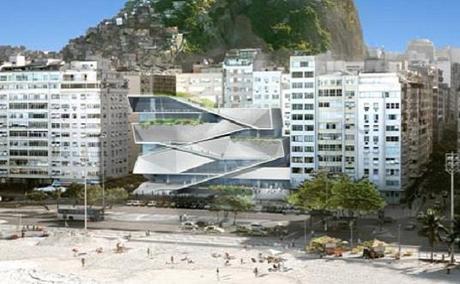Para los arquitectos ganadores del concurso, la arquitectura del museo surge de captar la esencia del sitio. En tal sentido, el diseño percibe ese atributo en la formalización de un edificio visto con la dinámica de un paseo público. De este modo, el edificio se concibe como extensión del boulevard marítimo diseñado por Roberto Burle Marx, un espacio público donde coexiste el tránsito a pie, en bicicleta y en automóvil en un tradicional itinerario contenido entre la costa marítima y la envolvente de fachadas de los edificios.

Esa condición de movimiento se traslada al edificio en sus rampas y circulaciones verticales, que se integran desde el exterior como una prolongación del paseo uniendo las actividades culturales, educativas, de ocio y de servicios del museo. La secuencia de circulación une el Auditorio ubicado a nivel de calle con la terraza elevada del Café, el Piano Bar del tercer nivel con el restaurante del sexto. Todas las actividades vinculadas entre sí, finalizando el recorrido en el cine al aire libre ubicado sobre el techo del edificio.
Esta forma de concebir la arquitectura propone un doble juego donde la ciudad no es el único espectador. El museo propone vivenciar la ciudad de una manera distinta, captada en la dinámica del recorrido. Un juego donde los edificios de la ciudad se exponen a los turistas y la actividad de la playa de Copacabana es absorbido desde el museo.
Marcelo Gardinetti, marzo de 2013© Imágenes: ©Diller Scofidio + Renfro.TECNNE | Arquitectura y contexto

Escrito en: Arquitectura
Autor: Marcelo Gardinetti
Fotografía: Diller Scofidio + Renfro.
Cite: "Marcelo Gardinetti, Museo de la Imagen de Rio de Janeiro; Tecnne"
Enlace corto: http://tecnne.com/?p=4725
Tags: Architecture, arquitectura, Brasil, brule marx, Concurso, destacado1, Diller Scofidio + Renfro, la esencia del sitio, Marcelo Gardinetti, Museo, museo de la imagen de rio de janeiro, museo de la imagen y el sonido, museum of the image of rio de janeiro, PDF, rio de janeiro
Los artículos de TECNNE se encuentran bajo la licencia Creative Comons | The articles of TECNNE are found under license Creative Comons
Deja un comentario

